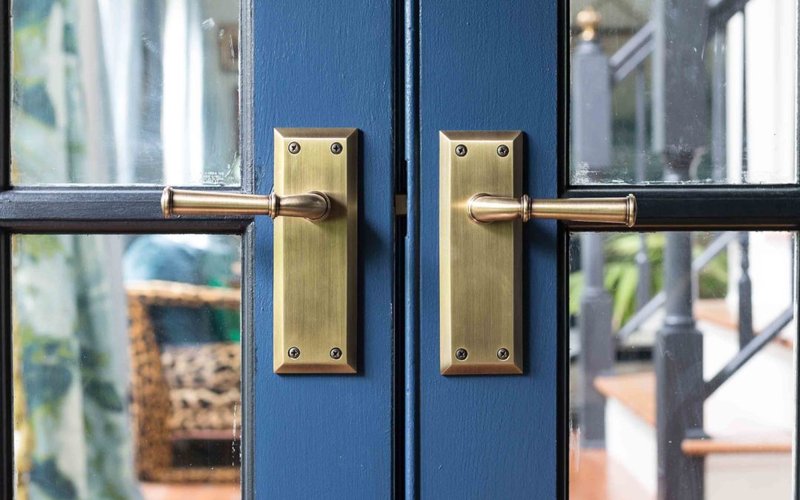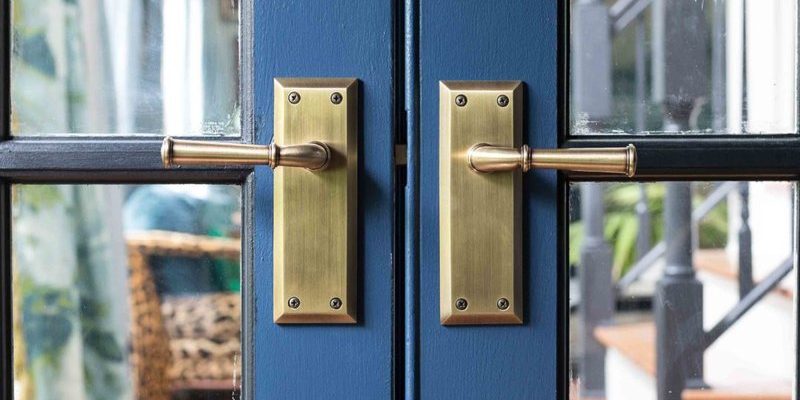
Honestly, anyone with Andersen, Pella, or even an off-brand set of French doors has probably noticed how quickly the hardware takes a beating. Rain, dirt, sun, the occasional over-enthusiastic door slam—it all adds up. The good news? You don’t need to be a pro to keep these doors gliding and latching like new. Most hardware issues—rusted hinges, sticky locks, wobbly handles—are completely avoidable with a little attention every now and then. Let me explain how to make your exterior French door hardware last for years (without turning it into a part-time job).
Why Regular Maintenance Matters for French Door Hardware
You might be wondering, “Isn’t door hardware just meant to work?” Well, it is… until it isn’t. French doors, especially the kind facing the outdoors, take more punishment than you might think. Rain brings moisture. Sun bakes finishes. Dirt, dust, and pollen sneak into crevices. Before you know it, you’re dealing with a rattling handle or a latch that sticks when you least expect it.
Here’s the thing—most of the problems start small: a little squeak, a stubborn spot, a tiny bit of rust. If you catch these early, a quick wipe or squirt of lubricant usually sets things right. Ignore them? Suddenly, you’re shopping for replacement hardware, or worse, trying to rehang an entire door after a hinge disaster.
The tough part is that exterior French door hardware isn’t cheap. Upgrading to *”weather-resistant stainless”* or a high-quality multi-point lock is an investment. Think of maintenance as your insurance policy—it keeps everything working smoothly, looking sharp, and holding off expensive repairs down the road. Honestly, a quick check-up two or three times a year will save you so much hassle.
Cleaning French Door Handles, Hinges, and Locks
Most people don’t think much about cleaning their door hardware, but it’s the easiest way to avoid trouble. Over time, fingerprints, dust, and outside grime can build up and start breaking down the finish or jamming up the works. Here’s the best way to keep things sparkling and smooth:
- Wipe with a soft, damp cloth—skip the harsh scrubbers or any cleaner with ammonia or bleach. Those can strip finishes and turn bright brass or matte black into a splotchy mess.
- Dry thoroughly after cleaning. Leaving water behind (even a little) is like rolling out the red carpet for rust, especially if you live somewhere humid or coastal.
- Q-tips or an old toothbrush are perfect for getting into tiny spots around decorative handles or tight hinge corners. Don’t underestimate the power of detailed cleaning—it’s like dental floss for your doors.
- For stubborn spots or grease, a dab of mild dish soap can help. Just rinse and dry after.
And for the love of all things shiny, never power-wash your hardware or use abrasive pads. That’s a fast ticket to scratches and chipped finishes—trust me, I’ve seen it happen.
Lubricating Hinges and Moving Parts
Lubrication is the secret sauce for smooth, quiet French doors. Hinges, mortise locks, multi-point deadbolts—they all have metal rubbing on metal, and that friction gets noisy and stiff over time. Neglect this step, and you’ll start hearing squeaks that could wake the neighbors.
Honestly, you don’t need to be an engineer to get this right. A can of silicone spray lubricant is your friend (skip the old-school oil, which attracts dust and gets sticky). Here’s a quick breakdown:
- Hinges: With the door open, give each hinge pin a short squirt. Open and close the door a few times to work it in.
- Lock bolts and latches: Spray a little into the keyhole, latch, and any sliding bolts. (Don’t flood it—just a quick shot does the trick.)
- Multi-point lock mechanisms: If your French doors have a handle that “throws” extra bolts top and bottom, lubricate those rods or rollers too.
- Wipe away any drips to prevent buildup and collect the excess with a paper towel.
Do this every few months, especially in spring and fall, and everything will keep moving like new. If things still feel sticky after a good lube, there could be deeper issues—maybe a bent hinge or worn-out lock.
Dealing With Rust and Corrosion
Even “weather-resistant” hardware can show rust eventually, especially if you’ve got salt air or humid summers. It usually starts small—maybe a reddish spot on a hinge, some pitting on a handle, or a little discoloration around lock edges. The best move is to catch and treat rust fast, before it spreads.
Here’s how to stay ahead of corrosion:
- Remove light rust: Use a mild abrasive pad or a baking soda paste (mix with a little water). Rub gently—don’t go at it like you’re scrubbing a BBQ grill.
- Rinse and dry completely when you’re done. Any leftover grit or moisture just invites more rust.
- Touch up damaged finishes with a matching metal paint or clear lacquer, if needed. This seals out future moisture.
If you’re seeing serious corrosion, especially inside a lock or hinge joint, it might be time to replace the part. But most of the time, a simple cleaning and a bit of touch-up is all you need. Honestly, a quick inspection after a big storm or once a season can catch rust early and keep things looking sharp.
Pro tip: If your area gets a lot of salty air or moisture, try applying a thin coat of clear wax (even car wax) to your hardware after cleaning. It acts as a barrier against the elements!
Tightening and Adjusting Exterior French Door Hardware
Over time, even the best-installed hardware starts to wiggle loose. Handles jiggle, locks feel sloppy, and hinges start to sag. You might not notice right away, but eventually, the door won’t close right or the latch won’t line up. Catch these small issues before they become big headaches.
Here’s what to look for:
- Loose handles or knobs: Flip the escutcheon (the decorative cover) or look for hidden set screws. Tighten these gently with the right screwdriver—no need to crank them down with all your might.
- Sagging hinges: If your door is starting to catch or scrape at the bottom, check that the hinge screws are tight. If they’re stripped, use a slightly longer screw or a wooden matchstick to fill the hole before reinstalling.
- Misaligned latches: If the door latch or deadbolt is tough to engage, you might need to move the strike plate on the door frame. A small shift—sometimes just a millimeter—can make a world of difference.
Don’t forget: always use the right screwdriver or Allen key. Stripping out hardware is a quick way to create bigger problems, so use a light touch and double-check that everything lines up before you call it done.
Protecting Hardware From the Elements
If your doors face direct sun, wind, or rain, you’ll want to give a little extra thought to protecting your exterior French door hardware. Metal doesn’t like constant moisture, and UV rays can fade even the toughest finishes over time.
Here are some easy ways to defend against the elements:
- Install an overhang or awning above your French doors if you don’t already have one—this blocks rain and harsh sunlight.
- Use weatherstripping around the door frame to block out driven water, dirt, and cold air. Replace cracked or worn-out stripping as soon as you spot it.
- Apply a yearly coat of protective wax or oil to the hardware. This is especially important if you’re in a coastal area or anywhere with harsh winters.
- Check for leaks when it rains. Water working its way behind the hardware can lead to hidden rust and wood rot.
Honestly, a little prevention here goes a long way. You can’t stop weather from happening, but you can make sure your hardware stands up to it like a champ.
When to Replace, Repair, or Upgrade Your Hardware
Sometimes, no amount of maintenance will save hardware that’s simply worn out or the wrong fit for your exterior French doors. If you’re dealing with constant sticking, sagging, or locks that just won’t “sync” up with your door anymore, it might be time for a change.
Here’s how to know what’s next:
- Replace: When handles, locks, or hinges are visibly cracked, rusted through, or the mechanism no longer works even after cleaning and lubrication.
- Repair: For small cosmetic damage (like scratched paint or minor dings) or when a single screw has stripped or gone missing.
- Upgrade: If you want a more secure lock, a different finish, or newer features (like smart locks or multi-point locking systems).
Upgrading hardware can also give your doors a brand-new look—even budget French doors get a serious style boost with modern, weather-resistant handles or sleek stainless hinges. Just make sure new hardware matches the existing holes and thickness of your doors. If you’re unsure, take the old piece to your local hardware store for help.
Simple Troubleshooting for Common French Door Hardware Problems
Let’s face it: even with the best tips, things don’t always go perfectly. Handles get stuck, keys stop turning, and something always seems to “feel off.” Don’t panic—most problems are easy to diagnose and fix, even for beginners. Here’s how to tackle the most common issues:
- Sticking door or latch: Clean out the latch area, tighten any loose screws, and lubricate the moving parts. Sometimes, the weather can swell the wood, so check if the door fits tightly in the frame.
- Key won’t turn: Try a spray of graphite or silicone lubricant in the keyhole. Avoid oil—it gums up over time. If it’s still jammed, the key or lock cylinder might be worn out and need replacement.
- Handle spins loosely: Usually a loose set screw. Tighten it with a small Allen wrench or screwdriver.
- Hinge squeaks or grinds: A quick squirt of silicone spray will silence most noisy hinges instantly.
Remember, if you ever feel out of your depth, don’t hesitate to call a locksmith or hardware pro. But nine times out of ten, a little patience and a pocketful of basic tools will get the job done without any drama.
Closing Thoughts: Keeping Your French Door Hardware in Great Shape
Exterior French door hardware is like the handshake your home offers the world—strong, welcoming, and maybe a little stylish, too. Keeping that hardware in top shape isn’t hard, but it does take a bit of regular attention. Cleaning, lubricating, tightening, and protecting from the weather will keep your doors moving smoothly and looking their best for years.
Think of these tips as your simple “checklist” for avoiding the most common headaches: rust, squeaks, and sagging. With just a few minutes a season, you’ll keep your locks secure and your handles shiny—whether you’ve got classic Andersen French doors, a modern Pella set, or any other brand. So, roll up your sleeves, give your hardware a little love, and enjoy French doors that work as beautifully as they look.
